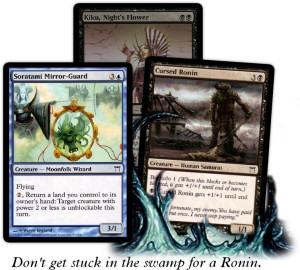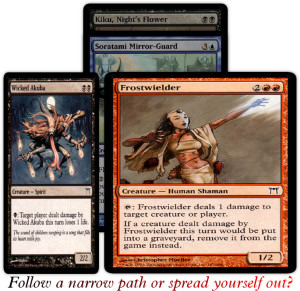One thing that seems to come up all the time when discussing draft picks or just draft in general is when you should stick to your color and when you should branch out by either choosing a second color or even switching one color for another.
In my opinion, this is usually the hardest decision that you make in a draft. Knowing if card A is better than card B is usually pretty easy, and knowing if card A is better suited for your deck than card B is not that hard either. Let me give you an example:
You are drafting CBS and open your first pack. It contains Rend Flesh, Honden of Cleansing Fire, and Kiku, Night’s Flower (and some weaker cards). Almost everyone “knows” that Kiku is the best card in this pack and since it’s the first pack we don’t really have many other factors to consider.
Some people do make the mistake in situations like these to take the single White card and pass the Black, hoping they will get a better setup for pack two. This is wrong for a number of reasons, but mainly since it’s impossible to know if you can keep cutting off the color you are trying to cut off. Only if two cards are really close in power should you let this factor decide your pick for you.
Anyway, we can all agree that knowing if card A is better than card B is “easy”. With so many people drafting and so many articles written on pick orders and such, it is more or less common knowledge how “good” each card is on its own.
Knowing when to pick a card that on its own has a lesser value because it has good synergy with your deck is trickier. This is because every draft is different than the last and every deck (or part of deck) is different. The only real way to get a good instinct for making the right pick in these situations is through repetition. The easier of these decisions take less repetitions while the hardest ones might never get “solved”. The good thing (or bad, depending how you look at it) is that these decisions are generally not that important. If for example you picked Split-Tail Miko over Waxmane Baku because you thought that you needed more Spirits/Arcanes at this point to make the Waxmane better, but in reality you were wrong, then that probably only affected this one pick and nothing else. This means that the impact that choice will have on your matches is small, and sometimes (because Magic is random) the pick will even turn out to be better over the course of the games played.

So, pick orders are easy to learn and these picks concerning power vs synergy are either “easy” or they don’t affect our decks much. Seems pretty easy to draft doesn’t it? There is one thing however that is both hard and that usually decide if we end up with a good deck or a bad one. Lets go back to our first example, where we windmill-slammed the Kiku first pick. Our second pack has a Soratami Mirror-Guard and nothing else very exciting. The best Black card is a Cursed Ronin. In much the same way as with the first pick, we would do ourselves a disservice by picking the Ronin just to send good signals.
In this situation there is actually added value to not taking the Ronin too. You see, we are actually keeping our options more open by picking the Soratami. If we pick the Ronin we are even more stuck in Black and we probably lose the option of going Blue at a later point. Or atleast if we go Blue we might not get much in pack two. By picking the Soratami we still have the option of abandoning Black with minimal loss if no Black is coming.
On the whole, this pick shouldn’t be that complicated since Mirror-Guard is just so much better than Cursed Ronin. We pick the Soratami and move on to the next pack. Or rather, we pick the Soratami and make a note of what the guy to our left is most likely to pick out of the rest of the pack. This might be important information later on.
Third pack is where it gets interesting. Our choice is between Wicked Akuba and Frostwielder (with nothing in Blue). The “sane” pick here I guess would be the Akuba. It’s in the same color as Kiku and it’s not much worse than Frostwielder. Why get into a third color and screw things up?
However, the same reasoning that applies to the second pick still applies here. If we take the Akuba there probably is no going back. We have to draft Black cards and for all we know the guy to our right has been drafting nothing but Black. If that’s the case then we will struggle to get enough Black to justify the double casting cost in both our Black cards.

If we instead pick the Frostwielder we get the option of either giving up on the Black or the Blue if cards of those colors don’t come to us in the next few picks. And if it does, we haven’t really lost that much (unless that Akuba we passed put our neighbour on the left into Black).
Don’t get me wrong, I’m not saying that Frostwielder is a clear pick here. The point of this exercise isn’t to dissect this one pick anyway, but rather to illustrate a point. The example I just gave might not have been that good either.
Spreading out your picks early might take away some options later on but it also gives you options you would not have had. With three cards in three different colors, picking a fourth color is probably not an option, but with more cards in one color you are in more trouble if that one color dries up.
Another obvious downside to spreading out is of course that one of the three cards we picked will probably end up in our sideboard. In that respect we are actually giving up power in our early picks to get better cards later, by choosing our colors when we have more information about what our neighbours are drafting.
There are of course a lot of other factors to consider before making a pick like this one. Sometimes the card of the third color is just way too good which usually means that the color is open on your right, making a stronger case for picking it (on top of it being a very good card of course). Also remembering what the packs have looked like so far is a big help. A color which has been lacking cards up to this point is a less attractive option, but on the other hand a color that you already passed good cards in could also be trouble since the guy on your left might cut you off in pack two.
It should also be noted that these critical picks don’t always happen this early. Sometimes you just get good cards passed in one color, maybe even for the whole first pack. Still, almost always you will have to choose at some point and the same reasoning still applies, but the later in the draft we have to choose, the better information we have about what colors are drafted close to us or what colors are underdrafted at the table as a whole.
So what about printruns then? Can’t we just use our knowledge of printruns and that way stay away from the color of our neighbour? Sometimes printruns can help us see what our neighbour first picked, but it is almost impossible to see what he picked out of later packs. Putting too much trust into printruns might screw you more than it helps you. What happens if your neighbour abandons his first pick? Suddenly you think he’s drafting a color that he isn’t which might lead to you giving good picks that should be in your deck to your other neighbour.
What’s the point then? We get these hard picks sometimes and there’s no real “rule” to follow on what pick is the right one. All this discussion back and forth about some theoretical pick and how it might make or break your draft but no solution? Well sadly, there just isn’t a solution. A good drafter (which usually translates into someone who has drafted lots and lots and lots) will develop some sort of instinct that helps him decide, but even the best drafters in the world come across picks where they have no clue what is right and wrong. This is what makes draft such an exciting format and one of the reasons most “pros” prefer draft to Constructed.
There is one thing you can do though. My belief is that most drafters belong to one of two camps – they either tend to stick too much to their early picks or they tend to abandon their early picks too often. So my advice to you is that while you are drafting, try to recognize when these hard decisions come up and remember what decision you made and what the result was. This way you should be able to see what kind of mistake you make the most and adjust accordingly. Another thing that I always try to mention is to discuss picks with your friends. Trying to improve your own game in a “vacuum” without the input of others is much less effective than improving through cooperation.
Hopefully this article hasn’t all just been theoretical drivel and I managed to get my point across. As always, if you have any questions/critique/suggestions post about it on the messageboard.
Until next time,
Anton Jonsson
